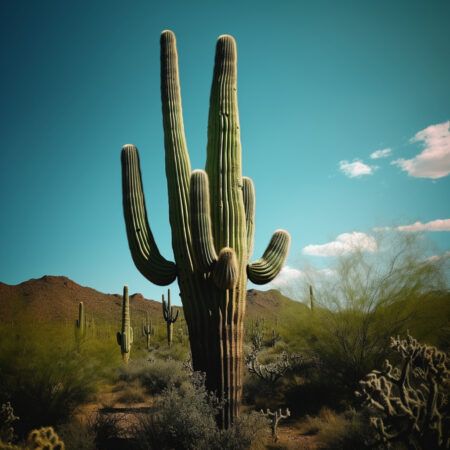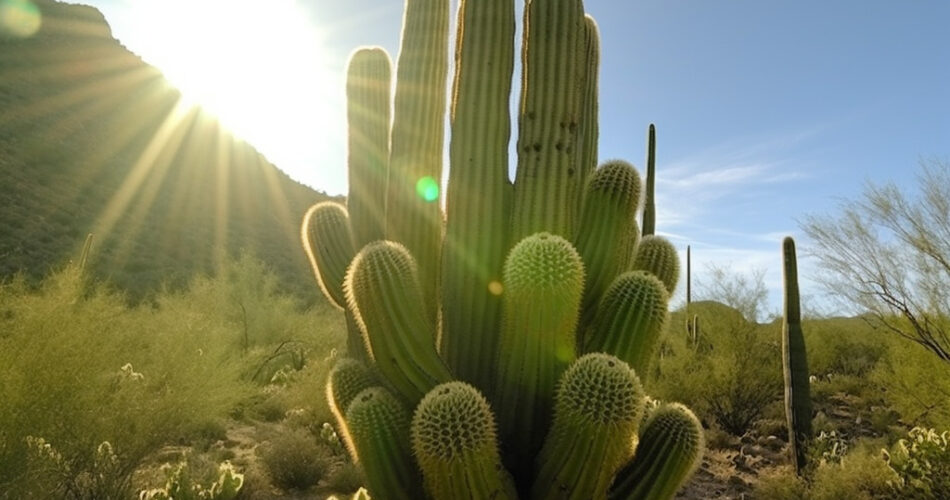Key Takeaways:
- It is a large, tree-like cactus that can grow up to 60 feet tall and live for over 150 years.
- This cactus has the ability to store water in its pleated stem, allowing it to survive in the desert.
- The life cycle of a this cactus starts with the germination of its seeds, which can take several weeks or months.
- Saguaro cacti are native to the Sonoran Desert and play a crucial role in the ecosystem as a keystone species.
- It can be found in parts of California, southern Nevada, and Mexico, with the highest concentration in southern Arizona.
- Growing this cacti requires a hot, arid climate with full sun exposure and well-draining soil.
- It can be propagated through seeds or asexual propagation methods like grafting and cuttings.
- This cactus holds cultural importance and faces threats from habitat loss and climate change.
- Efforts are being made to protect and preserve this cacti through conservation initiatives.
The Fascinating World of the Saguaro Cactus
The Anatomy and Physical Features of the Saguaro Cactus
The Saguaro cactus, scientifically known as Carnegiea gigantea, is an iconic symbol of the American Southwest. It is a large, tree-like cactus that can grow up to 60 feet tall and live for over 150 years. The Saguaro has a unique structure that sets it apart from other cacti. Its trunk is made up of rigid, woody ribs that provide support and allow it to grow tall.
One of the most remarkable features of the Saguaro is its capacity to store water. During dry periods, the Saguaro absorbs and stores water in its pleated, accordion-like stem. This allows it to survive in the harsh desert environment where water is scarce. The Saguaro’s ability to expand and contract as it absorbs and releases water is a testament to its extraordinary adaptations.
The Life Cycle and Growth of the Saguaro Cactus
The life cycle of a Saguaro cactus begins with the germination of its seeds. The majority of Saguaro seeds are dispersed by birds, which eat the cactus fruit and excrete the seeds in different locations. The germination process of Saguaro seeds is slow and can take up to several weeks or even months to sprout.
Once a Saguaro seed sprouts, it enters into its growth phases. During the initial years, the cactus forms a small, spherical shape known as the “crest.” As it matures, the Saguaro develops vertical arms that grow upward and outward. The growth rate of a Saguaro cactus varies depending on environmental factors such as water availability and temperature.
The remarkable lifespan of the Saguaro is another fascinating aspect of its growth. Studies have shown that Saguaro cacti can live for more than 150 years, with some specimens reaching up to 200 years old. This longevity is a testament to the cactus’s resilience and adaptability in the harsh desert environment.
The Natural Habitat and Distribution of Carnegiea gigantea
Exploring the Sonoran Desert
The Saguaro cactus is native to the Sonoran Desert, which spans parts of the southwestern United States and northwestern Mexico. The Sonoran Desert is a remarkable ecosystem characterized by its unique combination of climate, topography, and biodiversity.
Within the Sonoran Desert, the Saguaro cactus plays a crucial role in the ecosystem. It provides shelter, food, and nesting sites for a variety of desert wildlife, including birds, bats, and insects. The Saguaro is considered a keystone species because its presence has a significant impact on the overall health and balance of the desert ecosystem.
The Geographical Range of the Saguaro Cactus
While the Saguaro cactus is most commonly associated with the American Southwest, its geographical range extends beyond just Arizona. Saguaro cacti can also be found in parts of California and southern Nevada. However, the highest concentration of Saguaro cacti is found in southern Arizona, where they thrive in the arid desert conditions.
Saguaro cacti hold great historical and cultural significance in the American Southwest. They are often depicted in art, literature, and Native American traditions, symbolizing strength, resilience, and longevity. In Mexico, the Saguaro cactus is a symbol of national pride and can be found in various regions, particularly in the state of Sonora.
Growing and Caring for Saguaro Cacti
Creating the Perfect Environment
If you’re considering growing Saguaro cacti, it’s essential to provide them with the optimal environment for healthy growth. Saguaro cacti require a hot, arid climate with full sun exposure. They are not suitable for regions with cold winters or high humidity.
In terms of soil and drainage considerations, Saguaro cacti prefer well-draining soil with a sandy or gravelly texture. This allows excess water to drain away quickly, preventing root rot. It is crucial to avoid overwatering Saguaro cacti, as they are adapted to survive in water-scarce desert conditions.
Protecting Saguaro cacti from frost and freezing temperatures is also vital. These cacti are not frost-tolerant and can be severely damaged or killed by frost. If you live in an area prone to frost, it is recommended to grow Saguaro cacti in containers that can be moved indoors during colder months.
Propagation Techniques
There are several methods for propagating Saguaro cacti, including harvesting and planting seeds, as well as asexual propagation techniques. When harvesting Saguaro seeds, it is essential to obtain them from a reliable source or purchase them from reputable suppliers. The seeds should be planted in well-draining soil and kept slightly moist until germination.
Asexual propagation methods include techniques like grafting and cuttings. Grafting involves attaching a piece of an existing Saguaro cactus to a seedling, allowing it to grow faster. Cuttings, on the other hand, involve taking a segment of a mature Saguaro and rooting it to produce a new plant.
Once young Saguaro plants have been established, it is crucial to care for them properly. This includes providing adequate sunlight, watering sparingly, and protecting them from pests and diseases. As the plants grow, it may be necessary to provide support to prevent them from tipping over.

The Significance and Conservation of the Saguaro
The Cultural Importance of the Saguaro Cactus
The Saguaro cactus holds immense cultural importance and has been a source of inspiration in art, literature, and Native American traditions. It is often depicted as a symbol of strength, endurance, and the resilience of desert life. The arms of the Saguaro, reaching towards the sky, have been interpreted as a representation of spiritual growth and connection to the natural world.
In the modern cultural landscape, the Saguaro cactus continues to hold a special place. It is frequently used as a motif in architecture, interior design, and branding, representing the unique character of the American Southwest.
The Threats to Saguaro Cactus Populations
While the Saguaro cactus has managed to survive in the harsh desert environment for centuries, it faces several threats to its population. Habitat loss due to urbanization and land development is one of the most significant challenges. As human populations expand, the natural habitats of Saguaro cacti are destroyed or fragmented, limiting their ability to reproduce and thrive.
Climate change and drought also pose a threat to Saguaro cacti. Rising temperatures and prolonged drought periods can impact the cactus’s ability to store water and survive. Changes in precipitation patterns and extreme weather events further exacerbate these challenges.
Efforts are being made to protect and preserve Saguaro cacti through conservation initiatives and land management practices. These include the establishment of protected areas, restoration of degraded habitats, and public education on the importance of desert ecosystems.
In Conclusion
The Saguaro cactus, with its unique structure, extraordinary adaptations, and cultural significance, stands as an iconic symbol of the American Southwest. Its ability to thrive in the harsh desert environment and its role in maintaining the balance of the desert ecosystem make it a fascinating subject of study and admiration.
Growing and caring for Saguaro cacti requires a deep understanding of their specific environmental requirements, propagation techniques, and the importance of conservation. By valuing and protecting these majestic cacti, we can ensure their survival for future generations to appreciate and admire.
FAQ
Question: How tall can a Saguaro cactus grow?
A Saguaro cactus can grow up to 60 feet tall.
Question: How long can a Saguaro cactus live?
A Saguaro cactus can live for over 150 years, with some specimens reaching up to 200 years old.
Question: Where are Saguaro cacti native to?
These are native to the Sonoran Desert in the southwestern United States and northwestern Mexico.
Question: Do Saguaro cacti grow in places other than Arizona?
Yes, it can also be found in parts of California and southern Nevada, but the highest concentration is in southern Arizona.
Question: What kind of climate do Saguaro cacti require?
These cacti require a hot, arid climate with full sun exposure.
Question: How can Saguaro cacti be propagated?
Saguaro cacti can be propagated through seeds or asexual methods like grafting and cuttings.
Question: What threats do Saguaro cacti face?
This cacti face threats from habitat loss due to urbanization, land development, and climate change.
Question: What efforts are being made to protect Saguaro cacti?
Conservation initiatives and land management practices are being implemented to protect and preserve Saguaro cacti, including the establishment of protected areas and habitat restoration.




Comments